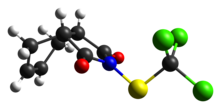This is the current revision of this page, as edited by 98.191.202.231 (talk) at 21:46, 8 September 2024 (Cat.). The present address (URL) is a permanent link to this version.
Revision as of 21:46, 8 September 2024 by 98.191.202.231 (talk) (Cat.)(diff) ← Previous revision | Latest revision (diff) | Newer revision → (diff) This article is about the fungicide. Not to be confused with ethyl mercaptan, which is used as an odorant for liquefied petroleum gas or kapton, a type of plastic film.
| |

| |
| Names | |
|---|---|
| IUPAC name (3aR,7aS)-2--3a,4,7,7a-tetrahydro-1H-isoindole-1,3(2H)-dione | |
| Identifiers | |
| CAS Number | |
| 3D model (JSmol) | |
| ChEBI | |
| ChEMBL | |
| ChemSpider | |
| ECHA InfoCard | 100.004.626 |
| KEGG | |
| PubChem CID | |
| UNII | |
| CompTox Dashboard (EPA) | |
InChI
| |
SMILES
| |
| Properties | |
| Chemical formula | C9H8Cl3NO2S |
| Molar mass | 300.58 g·mol |
| Appearance | white solid; yellow powder (commercial) |
| Density | 1.74 g/cm |
| Melting point | 178 °C (352 °F; 451 K) (decomposes) |
| Boiling point | N/A |
| Hazards | |
| Occupational safety and health (OHS/OSH): | |
| Main hazards | combustible, potential occupational carcinogen |
| NIOSH (US health exposure limits): | |
| PEL (Permissible) | none |
| REL (Recommended) | Ca TWA 5 mg/m |
| IDLH (Immediate danger) | N.D. |
| Except where otherwise noted, data are given for materials in their standard state (at 25 °C , 100 kPa).
| |
Captan is a general use pesticide (GUP) that belongs to the phthalimide class of fungicides. It is a white solid, although commercial samples appear yellow or brownish.
Applications
Although it can be applied on its own, Captan is often added as a component of other pesticide mixtures. It is used to control diseases on a number of fruits and vegetables as well as ornamental plants. It also improves the outward appearance of many fruits, making them brighter and healthier-looking. Captan is utilized by both home and agricultural growers and is often applied during apple production. It is also active against certain oomycetes, such as Pythium, making it useful for controlling damping off.
Biodegradation
The compound biodegrades with half life of less than 1 day in soil.
Potential health effects
Captan was previously cited as Group B2, a probable human carcinogen by the US Environmental Protection Agency (EPA), but was reclassified in 2004. Since the mode of action has been established as a proliferative response (in mice only) after intestinal villi are disrupted, captan has been deemed not likely to cause tumors at doses that do not irritate the intestine. The EPA now states, "The new cancer classification considers captan to be a potential carcinogen at prolonged high doses that cause cytotoxicity and regenerative cell hyperplasia. These high doses of captan are many orders of magnitude above those likely to be consumed in the diet, or encountered by individuals in occupational or residential settings. Therefore, captan is not likely to be a human carcinogen nor pose cancer risks of concern when used in accordance with approved product labels. A similar reclassification has been made for folpet, a structurally related fungicide, which shares a common mechanism of toxicity. A key finding for captan (and folpet) is these fungicides are not mutagenic in the animal (in vivo).
Production
It is the product of the reaction trichloromethylsulfenyl chloride with sodium salt of tetrahydrophthalamide, which is derived from tetrahydrophthalic anhydride.
References
- ^ NIOSH Pocket Guide to Chemical Hazards. "#0099". National Institute for Occupational Safety and Health (NIOSH).
- Captan (Icsc)
- ^ Franz Müller; Peter Ackermann; Paul Margot (2012). "Fungicides, Agricultural, 2. Individual Fungicides". Ullmann's Encyclopedia of Industrial Chemistry. Weinheim: Wiley-VCH. doi:10.1002/14356007.o12_o06. ISBN 978-3527306732.
- Dowling, Madeline; Peres, Natalia; Villani, Sara; Schnabel, Guido (2020). "Managing Colletotrichum on Fruit Crops: A "Complex" Challenge". Plant Disease. 104 (9): 2301–2316. doi:10.1094/PDIS-11-19-2378-FE. ISSN 0191-2917. PMID 32689886. S2CID 219479598.
- Review of Fungicides for Control of Phytophthora and Pythium Diseases on Potted Ornamentals
- EPA Captan Reregistration Eligibility Decision Facts Archived October 6, 2006, at the Wayback Machine
- US EPA. 2004. Captan: Cancer Reclassification; Amendment of Reregistration Eligibility Decision; Notice of Availability. Federal Register 69: 68357-68360
- Bernard, B. K., and Gordon, E. B. 2000. An evaluation of the common mechanism approach to the Food Quality Protection Act: Captan and four related fungicides, a practical example. Int J Toxicol 19: (1): 43-61.
- Kidwell, J. (2010). Cancer Assessment Document. Second Evaluation of the Carcinogenic Potential of Folpet. PC Code 081601. Cancer Assessment Review Committee, Health Effects Division, Office of Pesticide Programs, U.S. Environmental Protection Agency, USA. Folpet Cancer Assessment Document Final. Memorandum to Abdallah Khasawinah, RAB IV, Health Effect Division (7505P) and Tony Kish, Product Manager, Team 22, Fungicide Branch, Registration Division (7505P), through Mary Manibusan and Jess Rowland, Co-Chairs Cancer Assessment Review Committee, Health Effects Division (7509P), 53 Pages, October 13, 2010.
- Cohen, S. M., Gordon, E. B., Singh, P., Arce, G. T., and Nyska, A. 2010. Carcinogenic Mode of Action of Folpet in Mice and Evaluation of Its Relevance to Humans. Critical Reviews in Toxicology 40: (6): 531-545.
- Arce, G. T., Gordon, E. B., Cohen, S. M., and Singh, P. 2010. Genetic Toxicology of Folpet and Captan. Critical Reviews in Toxicology 40: (6): 546-574.
- Gordon, E. B. 2010b. Captan and Folpet. In: R. Krieger, ed. Hayes Handbook of Pesticide Toxicology pp. 1915-1949. Elsevier, New York
External links
- Captan Technical Fact Sheet - National Pesticide Information Center
- Captan General Fact Sheet - National Pesticide Information Center
- Captan Pesticide Information Profile - Extension Toxicology Network
- EPA Captan Reregistration Eligibility Decision Facts
- CDC - NIOSH Pocket Guide to Chemical Hazards - Captan